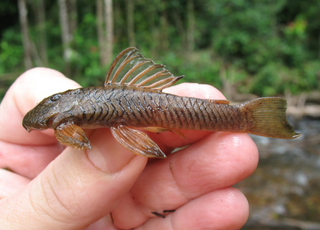
Hypostomus is a genus of catfish in the family Loricariidae. They are native to tropical and subtropical South America. H. plecostomus is the popular freshwater aquarium fish formerly known as Plecostomus plecostomus. The taxonomic structure of the Loricariidae is still being expanded by scientists. Hypostomus is a highly species-rich and widely distributed catfish genus.
Callichthys serralabium is a tropical freshwater fish belonging to the Callichthyinae sub-family of the family Callichthyidae.

The Hypoptopomatinae are a subfamily of catfishes of the family Loricariidae, composed of 17 genera and approximately 80 species. This subfamily represents about one-tenth of all loricariid species.
Hisonotus is a genus of armored catfishes native to South America. Species of Hisonotus and Curculionichthys are the only representatives of the subfamily Otothyrinae having serrae on the posterior edge of the pectoral fin spine. These species are small fishes, generally found in small fast flowing streams, where they grasp to the branches and leaves of aquatic or subaquatic plants. The species of this genus mostly occur in Atlantic coastal streams of southern Brazil and the Paraguay-Paraná system of southern South America. They are also distributed in the Río de La Plata basin and coastal rivers of southeastern Brazil.
Harttia is a genus of armored catfishes native to South America.
Pareiorhaphis is a genus of catfish in the family Loricariidae native to South America. This genus can be readily distinguished from other neoplecostomines by the unique combination of having fleshy lobes on lateral margins of head ornamented with hypertrophied odontodes on nuptial males, caudal peduncle ovoid in cross section, abdomen usually naked, dorsal fin spinelet ovoid and adipose fin usually present. The color pattern is usually dark brown and mottled with the abdomen white. Most species in to Pareiorhaphis were originally described in Hemipsilichthys. In 1918, Alípio de Miranda-Ribeiro proposed the new genus Pareiorhaphis. Whether Pareiorhaphis is monophyletic or not is currently unknown.

Parotocinclus is a genus of fish in the family Loricariidae native to South America. This genus is distributed through almost all hydrographic systems in South America from the Guyana Shield drainages and Amazon Shield tributaries to the coastal drainages of eastern and southeastern Brazil, including the rio São Francisco basin. Most species have the caudal peduncle oval in cross section. It has been found that Characidium species may interact with P. maculicauda. The small Characidium will follow grazing P. maculicauda, which release particulate matter dislodged from the catfish's foraging.
Pareiorhina is a genus of armored catfishes native to South America where they are only found in Brazil. These species are known to occur at altitudes above 650 metres (2100 ft) in various rivers of the Grande, Paraíba do Sul, São Francisco and Tietê River basins. This genus was first erected by Gosline in 1947 as a monotypic genus to include Rhinelepis rudolphi. It was not until 2003 that a second species, P. carrancas, was described. The third species, P. brachyrhyncha was described in 2005. Pareiorhina forms a monophyletic subunit with Neoplecostomus within the subfamily Neoplecostominae.
Isbrueckerichthys is a genus of armored catfishes which are endemic to Brazil.
Corumbataia is a genus of armored catfishes native to South America where they are only known from Brazil.
Otothyris is a genus of armored catfishes endemic to Brazil.

Homodiaetus is a genus of pencil catfishes native to South America.
Pseudolithoxus is a genus of suckermouth armored catfishes with five described species from the basins of the Orinoco, Casiquiare and upper Rio Negro in Venezuela. Additionally, a possibly undescribed species is known from the Trombetas and Nhamundá rivers in Brazil.

Cetopsis is a genus of catfishes of the family Cetopsidae.
Pseudotocinclus juquiae is a species of armored catfish endemic to Brazil where it is known from a few localities of the Juquiá River basin. The type locality, a small creek in Juquitiba, is clear, with a slow current, mud, and in some places, sand on the bottom. Marginal vegetation includes a small area of pastures, small trees and shrubs. P. juquiae has also been found in the ribeirão Poço Grande, a tributary on the right margin of the Juquiá River; this locality, an old swamp area near the city of Juquiá, is heavily impacted by human activities, and is also used for garbage and sewage disposal.
Pseudotocinclus parahybae is a species of armored catfish endemic to Brazil, where it is known only from the type locality, a tributary of the ribeirão Grande, rio Paraíba do Sul basin. It is a medium-size creek, 0.5–1.5 metres (1.6–4.9 ft) deep and 5.0 m (16.4 ft) wide at approximately 800 m (2600 ft) above sea level, on the slope of Serra da Mantiqueira, with very clear, well oxygenated, and fast flowing water, running mainly on stone beds.
Pseudotocinclus tietensis is a species of armored catfish endemic to Brazil where it occurs in many tributaries of the upper Tietê basin. It is found both in small creeks and medium size rivers such as the Paraitinga River, a tributary of the rio Tietê, where it lives grazing on semisubmersed overhanging plants. It is also found in the Rio Jurubatuba, a small sized river which drains to the Billings Dam near Vila de Paranapiacaba, Santo André. This species can be found attached to the grass along the river margin and in the middle of the river among rocks and pieces of wood in fast current water. This species grows to a length of 6 centimetres (2.4 in) SL.

Hisonotus acuen is a species of armored catfish from the Xingu River in Brazil.

Guyanancistrus nassauensis is a species of catfish belonging to the family Loricariidae, the suckermouth armored catfishes. It is discovered in 2005 and formally described in 2018. G. nassauensis is a rare species, highly endemic to the Nassau Mountains in Suriname, and is threatened with extinction by proposed or ongoing mining activities.
Parotocinclus dani is a species of catfish in the family Loricariidae. It is native to South America, where it occurs in tributaries of the Tapajós basin in Brazil.






